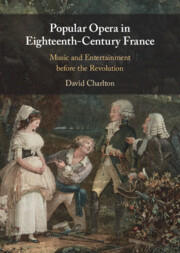Book contents
- Popular Opera in Eighteenth-Century France
- Popular Opera in Eighteenth-Century France
- Copyright page
- Dedication
- Epigraph
- Contents
- Illustrations
- Tables
- Examples
- Preface
- Acknowledgements
- Notes on the Text
- Abbreviations
- 1 Introduction
- 2 Music and Spoken Theatre
- 3 Music in Gherardi’s Company
- 4 Singing and Acting at Home
- 5 Opéra-comique en vaudevilles
- 6 Experiences of Popular Theatre
- 7 Comic and Serious Themes
- 8 Performance as History
- 9 Musical Expansion
- 10 Italian Inroads: The King’s Company
- 11 Six Methods of Synthesis
- 12 A ‘Musico-Dramatic Art’
- 13 Conclusions
- Stage Works Cited
- Bibliography
- Index
6 - Experiences of Popular Theatre
Published online by Cambridge University Press: 09 December 2021
- Popular Opera in Eighteenth-Century France
- Popular Opera in Eighteenth-Century France
- Copyright page
- Dedication
- Epigraph
- Contents
- Illustrations
- Tables
- Examples
- Preface
- Acknowledgements
- Notes on the Text
- Abbreviations
- 1 Introduction
- 2 Music and Spoken Theatre
- 3 Music in Gherardi’s Company
- 4 Singing and Acting at Home
- 5 Opéra-comique en vaudevilles
- 6 Experiences of Popular Theatre
- 7 Comic and Serious Themes
- 8 Performance as History
- 9 Musical Expansion
- 10 Italian Inroads: The King’s Company
- 11 Six Methods of Synthesis
- 12 A ‘Musico-Dramatic Art’
- 13 Conclusions
- Stage Works Cited
- Bibliography
- Index
Summary
Chapter 6 brings together evidence of all kinds from the whole period to create a vivid picture of popular opera and its audience in the theatre. ‘Theatre Size and Ambience’ correlates detailed historical information to produce a systematic overview of many theatre buildings, together with interior details and size of musical ensembles. Ticket admission prices at the Opéra, Comédie-Italienne and the Fair theatres are compared and assessed. Descriptions by a number of eyewitnesses (French, Italian, English, Irish and German observers) combine to give an impression of activity in popular theatre seen from the audience’s point of view. In a survey of staging, the evidence is both visual and textual: engraved and painted illustrations are analysed and ‘corrected’ so that the proportions of stage sets can be understood. Then a synopsis of stage directions suggests the material range of experience in popular opera. A survey of lighting effects is discussed in relation to stage context, showing how some comedies combined lighting effects with music.
Keywords
- Type
- Chapter
- Information
- Popular Opera in Eighteenth-Century FranceMusic and Entertainment before the Revolution, pp. 134 - 155Publisher: Cambridge University PressPrint publication year: 2021

